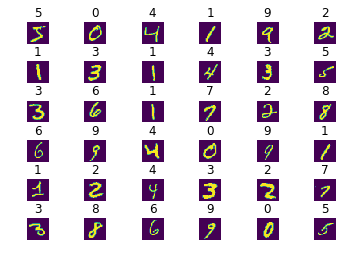基于Keras实现mnist-官方例子理解
前言
久闻keras大名,最近正好实训,借着这个机会好好学一下。
首先推荐一个API,可能稍微有点旧,但是写的是真的好
https://keras-cn.readthedocs.io/en/latest/
还有一个tensorflow的API
https://www.w3cschool.cn/tensorflow_python/?
还有强烈推荐使用vscode+anaconda 配置环境
环境
安装anaconda和vscode,在conda中新建keras的环境。
conda create -n keras python=3.6
pip install tensorflow # 如果有GPU改为pip install tensorflow-gpu
pip install keras
正题
mnist是入门级别的数据集,是一个基本的分类数据集。这次尝试构造深度神经网络来构造一个图像分类器。
import keras
from keras.datasets import mnist
import numpy as np
from PIL import Image
import matplotlib.pyplot as plt
from keras.models import Sequential
from keras.layers import Dense,Conv2D,MaxPooling2D,Flatten
import cv2
import matplotlib
matplotlib.use('TkAgg')
batch_size=32
num_classes=10
(train_images,train_labels),(test_images,test_labels) = mnist.load_data()
print(train_images.shape,train_labels.shape)
print(test_images.shape,test_labels.shape)
"""
将数据集中图片展示出来
"""
def show_mnist(train_image,train_labels):
n = 3
m = 3
fig = plt.figure()
for i in range(n):
for j in range(m):
plt.subplot(n,m,i*n+j+1)
#plt.subplots_adjust(wspace=0.2, hspace=0.8)
index = i * n + j #当前图片的标号
img_array = train_image[index]
img = Image.fromarray(img_array)
plt.title(train_labels[index])
plt.imshow(img,cmap='Greys')
plt.show()
img_row,img_col,channel = 28,28,1
mnist_input_shape = (img_row,img_col,1)
#将数据维度进行处理
train_images = train_images.reshape(train_images.shape[0],img_row,img_col,channel)
test_images = test_images.reshape(test_images.shape[0],img_row,img_col,channel)
train_images = train_images.astype("float32")
test_images = test_images.astype("float32")
## 进行归一化处理
train_images /= 255
test_images /= 255
# 将类向量,转化为类矩阵
# 从 5 转换为 0 0 0 0 1 0 0 0 0 0 矩阵
train_labels = keras.utils.to_categorical(train_labels,num_classes)
test_labels = keras.utils.to_categorical(test_labels,num_classes)
"""
构造网络结构
"""
model = Sequential()
model.add(Conv2D(32,kernel_size=(3,3),
activation="relu",
input_shape=mnist_input_shape))
# kernalsize = 3*3 并没有改变数据维度
model.add(Conv2D(16,kernel_size=(3,3),
activation="relu"
))
model.add(MaxPooling2D(pool_size=(2,2)))
# 进行数据降维操作
model.add(Flatten())#Flatten层用来将输入“压平”,即把多维的输入一维化,
#常用在从卷积层到全连接层的过渡。Flatten不影响batch的大小。
model.add(Dense(32,activation="relu"))
#全连接层
model.add(Dense(num_classes,activation='softmax'))
"""
编译网络模型,添加一些超参数
"""
model.compile(loss=keras.losses.categorical_crossentropy,
optimizer=keras.optimizers.Adadelta(),
metrics=['accuracy'])
model.fit(train_images,
train_labels,
batch_size=batch_size,
epochs=5,
verbose=1,
validation_data=(test_images,test_labels),
shuffle=True
)
score = model.evaluate(test_images,test_labels,verbose=1)
print('test loss:',score[0])
print('test accuracy:',score[1])
其中涉及到几个keras中的点,感觉看完以后很透彻,但是这只是初步应用,之后还会继续再写的。

jupyter notebook 版本的请访问:https://github.com/pprp/keras-example/tree/master/implement/mnist_keras/
欢迎访问我的Github:https://www.github.com/pprp/ star fork 感激不尽
基于Keras实现mnist-官方例子理解的更多相关文章
- 基于Keras 的VGG16神经网络模型的Mnist数据集识别并使用GPU加速
这段话放在前面:之前一种用的Pytorch,用着还挺爽,感觉挺方便的,但是在最近文献的时候,很多实验都是基于Google 的Keras的,所以抽空学了下Keras,学了之后才发现Keras相比Pyto ...
- 基于tensorflow的MNIST手写数字识别(二)--入门篇
http://www.jianshu.com/p/4195577585e6 基于tensorflow的MNIST手写字识别(一)--白话卷积神经网络模型 基于tensorflow的MNIST手写数字识 ...
- Caffe系列4——基于Caffe的MNIST数据集训练与测试(手把手教你使用Lenet识别手写字体)
基于Caffe的MNIST数据集训练与测试 原创:转载请注明https://www.cnblogs.com/xiaoboge/p/10688926.html 摘要 在前面的博文中,我详细介绍了Caf ...
- [深度应用]·首届中国心电智能大赛初赛开源Baseline(基于Keras val_acc: 0.88)
[深度应用]·首届中国心电智能大赛初赛开源Baseline(基于Keras val_acc: 0.88) 个人主页--> https://xiaosongshine.github.io/ 项目g ...
- 基于 Keras 用 LSTM 网络做时间序列预测
目录 基于 Keras 用 LSTM 网络做时间序列预测 问题描述 长短记忆网络 LSTM 网络回归 LSTM 网络回归结合窗口法 基于时间步的 LSTM 网络回归 在批量训练之间保持 LSTM 的记 ...
- 基于 Keras 用深度学习预测时间序列
目录 基于 Keras 用深度学习预测时间序列 问题描述 多层感知机回归 多层感知机回归结合"窗口法" 改进方向 扩展阅读 本文主要参考了 Jason Brownlee 的博文 T ...
- 基于TensorRT的BERT实时自然语言理解(下)
基于TensorRT的BERT实时自然语言理解(下) BERT Inference with TensorRT 请参阅Python脚本bert_inference.py还有详细的Jupyter not ...
- 基于TensorRT的BERT实时自然语言理解(上)
基于TensorRT的BERT实时自然语言理解(上) 大规模语言模型(LSLMs)如BERT.GPT-2和XL-Net为许多自然语言理解(NLU)任务带来了最先进的精准飞跃.自2018年10月发布以来 ...
- 最简单的基于FFmpeg的移动端例子:IOS 视频解码器-保存
===================================================== 最简单的基于FFmpeg的移动端例子系列文章列表: 最简单的基于FFmpeg的移动端例子:A ...
随机推荐
- 【TensorRT】自定义网络层的实现custom layers
参考 1. Extending TensorRT With Custom Layers; 2. TensorRT Samples: MNIST(Plugin, add a custom layer); ...
- Cas(08)——单点登出
单点登出 目录 1.1 Cas Client端配置单点登出 1.2 Cas Server端禁用单点登出 1.1 Cas Client端配置单点登出 单点登出功能跟单点登录功能是 ...
- 【GStreamer开发】GStreamer播放教程04——既看式流
目的 在<GStreamer基础教程--流>里面我们展示了如何在较差的网络条件下使用缓冲这个机制来提升用户体验.本教程在<GStreamer基础教程--流>的基础上在扩展了一下 ...
- 软件素材---C语言函数不确定个数的入参的处理
1 : #用来把参数转换成字符串 #define P(A) printf("%s:%d\n",#A,A);int main(int argc, char **argv) { ...
- java绘图(基于Graphics2D)
1.绘图基本操作 请参考下面基础示例: int width = 200, height = 250; //创建图片对象 BufferedImage image = new BufferedImage( ...
- lnmp二级域名配置相关
阿里云那域名解析那有误读 我在偏远的电信网选择中国联通解析死活解析不出来 以上这么配置就对了....选择默认.瞬间解析出来.... 出于对nginx 配置不够熟悉 后来一点点理出来. 不带www 也正 ...
- 自定义注解扩展springMvc的validation注解
文章目录 前言 自定义校验注解 使用 后记 前言 我们都知道 springMvc 的检验框架使用的是 hibernate 的 validator ,检验数据,是有那么一点小爽快: 但是,validat ...
- 剑指offer61:序列化二叉树
1 题目描述 请实现两个函数,分别用来序列化和反序列化二叉树 二叉树的序列化是指:把一棵二叉树按照某种遍历方式的结果以某种格式保存为字符串,从而使得内存中建立起来的二叉树可以持久保存.序列化可以基于先 ...
- C 语言字符串的比较
C 语言字符串的比较 #include <stdio.h> #include <Windows.h> #include <string.h> int main(vo ...
- 初始NLTK
NLTK官网:链接 Natural Language Toolkit NLTK corpora and lexical resources such as WordNet, along with a ...
